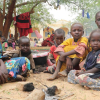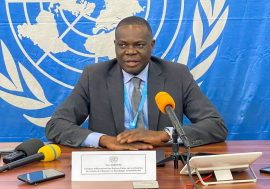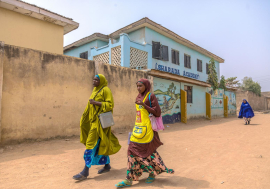Africa has a “window of opportunity” to avoid a new debt trap
Africa has a “window of opportunity” to avoid a new debt trap
African countries should seize the “window of opportunity” provided by a comprehensive debt relief programme offered by the World Bank and the International Monetary Fund (IMF) to the world’s poorest countries, Amadou Sy, Director of the Africa Growth Institute at the Brookings Institution, told Africa Renewal’s Jocelyne Sambira. The Heavily Indebted Poor Countries (HIPC) Initiative and related Multilateral Debt Relief Initiative (MDRI) have relieved 36 countries of $96 billion in debt. Thirty of these countries are in Africa. In this interview, Mr. Sy shares his thoughts on what should be done to avoid a future debt trap.
Africa Renewal: The two major debt relief programmes are reportedly coming to an end. Can you confirm and if so, how many countries in Africa have benefited from these plans?
Amadou Sy: By the end of April 2015, Chad became the 36th country when it received $1.1 billion in debt relief through the World Bank and the International Monetary Fund under the Heavily Indebted Poor Countries Initiative and the related Multilateral Debt Relief Initiative. There are currently only three countries in Africa that have not yet benefitted from the debt relief, notably Eritrea, Somalia and Sudan [they are classified as “pre-decision countries” which according to IMF means they “face common challenges including preserving peace and stability, improving governance and delivering basic services”]. As a result of this debt relief, the median government debt-to-GDP ratio in Africa fell drastically and it's now below 40%, which is reasonable and for obvious reasons, because some countries had debt relief. Now, if you look at the models that try to assess the risk of external debt distress – like the one used by the IMF and the World Bank – you will see very few countries are currently at risk of debt distress, except for Chad and São Tomé e Príncipe and the Central African Republic, which is in crisis.
Do you believe the HIPC and its related MDRI debt relief programme have been good for these African countries?
The debt relief really helped relieve the debt burden of these countries and reduce the risk of debt distress. If you look at what African countries are doing, they are implementing an agenda for transformation. So basically kick-starting the engines of their economies – agriculture, business, manufacture, industry and also addressing a huge infrastructure gap, which according to a 2009 World Bank paper, puts the infrastructure gap for Africa at about $93 billion per year. And that requires money because the gap is too large for most countries to be filled just by using government and private sector revenues.
So, many African governments are borrowing again. And – as you have seen – many countries are issuing eurobonds again. Fifteen years ago, only South Africa issued eurobonds but now you have Kenya, Rwanda, Senegal, Cote d'Ivoire and others issuing them. Now the key question is what are they doing with this money? Is there a risk that we could go into debt distress again? Before debt relief, most government revenues would go to service debt instead of going to pay health, education and investment expenditures. Two key questions: what are these governments doing with the money? And are they managing their new debt in an efficient, cost-effective way that will not increase again the risk of debt distress?
An economist explained to me that debt relief did not translate into liquid assets or cash because it was money that was owed. So, does that mean there was no money exchanged?
No. But the question is; before, when you would raise your tax revenues, you would spend most of it paying back your debt service. Now, you can put that money to other use. So the question again is what are countries doing? The IMF has a report called Macroeconomic Developments in Low-Income Developing Countries, which examines what countries are doing, case by case, and it has looked at only six countries: Djibouti, Kenya, Mozambique, Ghana, Haiti and Honduras. For example, IMF notes that in general, poverty-reducing social spending has not increased in these countries. And they also found that in some countries, like Ghana, budget overruns on current expenditure contributed to elevated deficits. So in the case of Ghana, the wage bill increased, the country also imported more than it exported and is back on an IMF programme. It's less a question of how elevated the debt-to-GDP ratio is. Of course you have countries like Cape Verde, which now has 112% of debt-to-GDP ratio from 65% in 2009.
What does that mean?
Basically, Cape Verde has been increasing its debt. If you take other countries like Ghana, it has decreased its debt-to-GDP ratio from about 80% in 2003 all the way down to 30% after the HIPC and MDRI debt relief. And now it is back to about 70%. So, the question is: What are you doing with the money, especially if you are interested in investment and infrastructure…are the investments helping you grow faster and generate the revenues to pay back your debt? Are you reducing the existing inefficiencies in public investment so as to “spend better?”
The second question is: Is your debt management office doing its job? A debt management office is there to make sure that when you borrow, you borrow at the lowest cost possible and also make sure that your debt dynamics are such that you are not going to run into problems in the future. For example, you can issue a new debt at a cheaper price to retire an old debt that was more expensive. So that type of debt exchange might make sense – it makes sense actually. But if you issue a new debt just to pay your wage bills, then you will run into trouble. In terms of policy advice, therefore, you have to have really strong debt management practices, a good fiscal policy (without which you will not be able to generate the necessary revenues to service your debt), and also make sure that your investments are the right ones and money is spent efficiently. The infrastructure that you are building will generate growth.
But having said this, I have an issue with African countries borrowing externally without developing their domestic debt market. What I mean is, take the example of Ghana. It is cheaper for Ghana to issue debt outside the country in foreign currency (in dollars) than to issue locally. Why? Because locally inflation is high, the debt is mostly bought by local banks so interest rates are high domestically. The key thing going forward is to really develop your own debt markets, develop your money markets and why not have regional money markets like it’s happening in the West Africa monetary union.
Can you elaborate?
In the West African monetary union you have eight countries that have the same currency and one central bank that has managed to develop a regional bond debt market. So, Cote d'Ivoire can issue a bond or a treasury bill and it can be purchased in any of the other seven countries of the monetary union. I think this is key.
Right now, domestic revenue mobilization should really be the focus when we are talking about financing for development. It’s the largest source of money for African governments. It’s larger than aid money and also private sector money coming from outside – from direct investment and so on. We really need to develop the right domestic revenue mobilization policies and have our own money markets and domestic debt markets. It is something that we can control. It also means we have to develop our institutional investors. The pension funds and the insurance companies and so on.
Is that what you mean by “maximizing innovative financing”?
Maximizing innovative financing actually comes from a document called the Common African Position (CAP) for Financing for Development Post-2015. What is key is that when we go to Addis Ababa for the Financing for Development (FfD) meeting in July 2015, Africa, unlike other regions, has a common position. And in that common position, African countries have agreed among other things to "maximize innovative financing". So what do they mean? They mean to develop mechanisms that make better use of the remittances Africa is getting. Reduce the remittance transfer costs. Most remittances go towards consumption but maybe there is a way that it should go to investment as well. This is of course private individuals' money, so it’s their money. I think if a bank sees the same person coming every month to collect remittances from a relative who is in Europe, for example, the bank can see the predictability. If it’s so predictable maybe that bank could say [to the client] “Hey, I can lend you $200-$300 so you can do some business because I can see for the past three years you have always been getting $500 a month.”
Another thing also is this long-term, non-traditional financing mechanism. For example, there is a huge pool of savings outside Africa in sovereign wealth funds. Sovereign wealth funds are long-term investors. They have a very long-term horizon and they want safe investments. How do you get that money to go into the infrastructure projects in Africa which are long-term?
May be we need to think a little bit more into having standardized securities to attract the sovereign wealth funds once the infrastructure projects are built and generate cash flows. But to start with, we need more financing from the African Development Bank, the World Bank and other development banks for greenfield infrastructure projects, especially for regional projects like Programme for Infrastructure Development in Africa (PIDA).
So would you say that the situation in Africa and its future concerning debt is positive for the moment?
I would say that we have a window of opportunity. We had debt relief so governments can now deploy their revenues to really productive investments instead of paying back this large debt burden that they had. So if you have that window of opportunity, you should seize it.
The other thing also is [that] we should be avoiding fiscal slippages, improving the quality of our investment spending, and monitoring and managing the debt that we have now so we avoid falling into the trap that we were in before when we had unsustainable debt.












